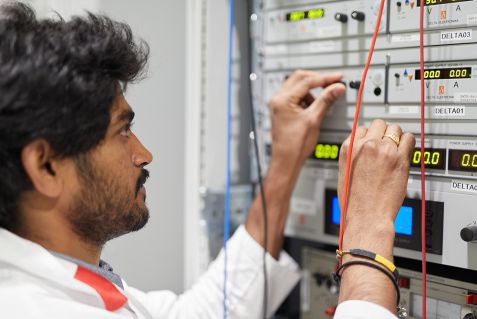MLZ is a cooperation between:
 > Technische Universität München
> Technische Universität München > Helmholtz-Zentrum Hereon
> Helmholtz-Zentrum Hereon
 > Forschungszentrum Jülich
> Forschungszentrum Jülich
MLZ is a member of:
 > LENS
> LENS > ERF-AISBL
> ERF-AISBL
MLZ on social media:

MLZ (eng)
Lichtenbergstr.1
85748 Garching
05.07.2021
Making data available to all

Engineer Muni Poli at the Heinz Maier-Leibnitz Zentrum sets the measurement parameters on the scientific instrument POLI. © Bernhard Ludewig
Who has not experienced this: Once a doctoral student has finished and leaves the research group, much data are also effectively lost? A new consortium is working to ensure that this no longer happens in the future by making research data more accessible and sustainable. DAta from PHoton and Neutron Experiments (DAPHNE4NFDI) will be funded for five years as part of the National Research Data Infrastructure (NFDI).
DAPHNE4NFDI is supported by more than 5500 neutron and photon users in Germany. They represent many different disciplines – from biology, pharmacy, engineering, physics, and chemistry to geology and archaeology. All of them face the common challenge of not only coping with the increasing demand for fast analysis of large data volumes and data transfer rates, but also organizing the data according to “FAIR” principles. FAIR stands for Findable, Accessible, Interoperable, and Reusable and describes the criteria for sustainable usability of data.
Karliczek: “Research data are the ticket to entry”
On July 2, the Joint Science Conference (GWK) decided to include ten consortia in the federal-state funding of the NFDI. Based on a funding recommendation from the German Research Foundation (DFG), this means that DAPHNE4NFDI will also be funded. The Vice Chair of the GWK, Anja Karliczek, Federal Minister of Education and Research, welcomed the decision: “Research data are the ticket to the future for Germany as a country of innovation. If we exploit this data with the greatest possible benefit, we will strengthen our competitiveness and our technological sovereignty.”
Electronic instead of handwritten lab book
The consortium of 18 partners will focus on five goals: Metadata in measurements will be captured even better. For example, in the future, the temperature at which measurements are taken will be automatically written down along with the measurement data and stored in a database. “We want to introduce an electronic lab book instead of the previous handwritten records,” explains Dr. Wiebke Lohstroh, who is applying for and supervising DAPHNE on the part of the Technical University of Munich at MLZ.
Making data findable
Another task is so-called data catalogs, which make the data easier to find. Here, the raw data are given a Digital Object Identifier (DOI) and linked to the published data. “If this is also extended to samples (sample ID), measurements at different large-scale research institutions on the same sample can be linked, for example,” says Wiebke Lohstroh. This would also be a step toward machine learning, i.e. artificial intelligence, which could evaluate the data across the board.
Software available to all
The third task will also play a major role not only in times of Corona: Experiments from outside (remote access) should be made possible, so that the guest scientists no longer have to be on site. For this purpose, MLZ’s own software must be made available to the guests. Conversely, the evaluation software of the users of large research institutions could be prepared and maintained in such a way that it is available to others.
Using synergies
Since not only MLZ is involved in the project, but also 15 other universities in addition to TUM, Forschungszentrum Jülich and Helmholtz-Zentrum Hereon, the networking of the individual partners within and outside the consortium plays a decisive role in the fourth task. “DAPHNE4NFDI thrives on the collaboration of researchers at universities and the participating large-scale research institutions in the field of photon and neutron scattering especially when it comes to metadata standards and acquisition,” says Wiebke Lohstroh. An exchange with the other NFDI consortia funded by the German Research Foundation (DFG) is also planned.
Publicizing the new service
Finally, training and public relations also play a role in the project. For example, informing a broad base of people about the new offerings through workshops. After all, the ‘FAIR’ data should be used by all researchers.
More information:
The three partners of the MLZ are involved in DAPHNE4NFDI as follows: The Technical University of Munich has applied for six positions, the Research Center Jülich for two, and the Helmholtz Center Hereon for one for neutron research. On the part of Forschungszentrum Jülich, Dr. Astrid Schneidewind is involved in the DAPHNE4NFDI consortium on behalf of MLZ, and Dr. Sebastian Busch is involved on behalf of Helmholtz Center Hereon. Spokesperson of the consortium is the German Electron Synchrotron DESY.
- Homepage of the consortium (under construction)
- Press release of the Forschungszentrum Jülich
- Press release of the Committee Research with Neutrons
Partners of the DAPHNE4NFDI:
Funding recipients are 18 different universities, research institutes, and major research centers where scientists have organized themselves under the leadership of the Committees for Synchrotron or Neutron Research (KFS, KFN) to work closely with other NFDI consortia to advance the establishment of the new research data infrastructure. The spokesperson of the consortium is Dr. Anton Barty from DESY. Researchers from eleven other institutions in Germany and abroad are contributing their expertise and methodology to pilot projects.
- Deutsches Elektronen-Synchrotron (DESY)
- Universität Kiel
- Universität Siegen
- Technische Universität München, FRM II
- Karlsruher Institut für Technologie
- Friedrich-Alexander-Universität Erlangen-Nürnberg
- Technische Universität Berlin
- Bergische Universität Wuppertal
- Georg-August Universität Göttingen
- Ludwig-Maximilians-Universität München
- Eberhard-Karls-Universität Tübingen
- RWTH Aachen
- European XFEL GmbH
- Forschungszentrum Jülich GmbH
- Helmholtz-Zentrum hereon GmbH
- European Molecular Biology Laboratory
- Helmholtz-Zentrum Berlin
- Helmholtz-Zentrum Dresden-Rossendorf
MLZ is a cooperation between:
 > Technische Universität München
> Technische Universität München > Helmholtz-Zentrum Hereon
> Helmholtz-Zentrum Hereon
 > Forschungszentrum Jülich
> Forschungszentrum Jülich
MLZ is a member of:
 > LENS
> LENS > ERF-AISBL
> ERF-AISBL
MLZ on social media:


